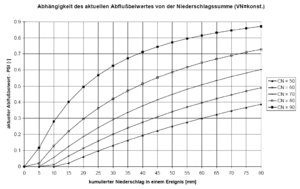SCS-Method
![]() BlueM.Sim | Download | Application | Theory | Development
BlueM.Sim | Download | Application | Theory | Development
BlueM.Sim theory
Event specific run-off coefficient on the basis of the Curve-Number-Method (CN-Method)of the Soil-Conservation-Service (SCS)
Theory
The Method applied in BlueM is a further development of the CN-Method (USDA (1964)[1]) by Zaiß (1989)[2]
By supplying a soil type and land use dependent CN (refer toDVWK (1991)[3]) an antecedent dependent initial loss as well as an antecedent dependent relationship of the run-off coefficient on the accumulated amount of rain up to a desired point in time can be determined. This results in an increasing run-off coefficient due to the accumulating rain amount in the course of a rainfall event.
A current run-off coefficient can be determined in dependency of the quantified previous history, as described above, by using the area specific and for average antecedent moisture conditions (AMC) (USDA (1964)[1]) valid CN.
In Abbildung 36 the development of the run-off coefficient depending on previous history is depicted for different CN.
As soil moisture increases during the course of a rainfall event the conditions for run-off development change which is why the run-off coefficient is additionally adjusted during a rainfall event as a function of accumulated rain. This correlation is depicted for different CN in Abbildung 37.
- Attention
- The CN-Method was developed for the simulation of solitary events on a daily basis. A further development is being undertaken for continuous simulation with smaller time steps.(refer to Bug 23 and Discussion)
Calculation
one-time calculated parameters
Input: CNII
Conversion of CNII to CNI:
- [math]\displaystyle{ CN_I = \frac{CN_{II}}{(2.3340 - 0.01334 \cdot CN_{II})} }[/math]
Maximum retention capability of the area (storage capacity) Smax [mm]:
- [math]\displaystyle{ S_{max} = \frac{25400}{CN_I} - 254 }[/math]
area specific initial loss Ia [mm]:
- [math]\displaystyle{ I_a = a \cdot S_{max} }[/math]
- with
a= constant, originally set to0,2[1], adjusted to European conditions in BlueM as0,05[3]
Krümmungsparameter CVW:
Laut Sartor[4], der die selbe Gleichung verwendet, stammt dieser Ansatz aus der Dokumentation von SMUSI 3.0
- [math]\displaystyle{ CVW = \frac{-100.}{\ln(\frac{0.5}{I_a})} }[/math]
- entspricht
b1in Gl. 4.5b in Zaiß (1989)[5] - laut Zaiß:
Eine Abhängigkeit des "Krümmungsparameters" b1 von Gebietskenngrößen konnte im Rahmen dieser Arbeit nicht gefunden werden. Sie läßt sich nach den hier aufgeführten Zusammenhängen lediglich über Regressionsanalysen mehrerer N-A-Ereignisse für das jeweils betreffende Einzugsgebiet ermitteln.
continuously calculated parameters
previous history
Previous history is quantified through the 21-day-antecedent rain index VN:
- [math]\displaystyle{ V_N = \sum_{j=0}^{21} C(j)^j \cdot h_{N,j} }[/math]
- Gl. 2.1 in Zaiß (1989)[6]
- with
hN,j= rain height of the preceding day j (j = 0is the current day)C(j)= factor, which describes the influence of the preceding day j
Seasonal influence is considered through the annual pattern of factor c.
- [math]\displaystyle{ C = 0.85 \cdot \sin\left(\frac{2 \pi}{365}\right) (i + 0.75 ) + 0.85 }[/math]
- Quelle? bei Zaiß finden sich nur so ähnliche Formeln (2.2 & 2.3)
- with
i= ongoing day of the hydrological year
C will alternate between 0,8 < C < 0,9. This allows for different antecedent rain indices due to seasonal differences for same antecedent rain amounts and thereby leads to different conditions for run-off development.
Event dependent initial loss
- [math]\displaystyle{ h_{va} = I_a \cdot e^{-\frac{V_N}{CVW}} }[/math]
- Gl. 4.5b in Zaiß (1989)[7]
run-off coefficient
- [math]\displaystyle{ \psi = \begin{cases} 0, & h_{va} \ge h_{NE} \\ 1 - \left(\frac{h_{va}}{A_v \cdot h_{NE} + (1 - A_v) \cdot h_{va}}\right)^2, & h_{va} \lt h_{NE} \end{cases} }[/math]
- Gl. 4.4 in Zaiß (1989)[8]
- with
Av= loss ratio =0,05hNE= event-driven sum of rainfall [mm]
Literature
- ↑ 1.0 1.1 1.2 U.S. Department of Agriculture, Soil Conservation Service (1964): National Engineering Handbook, Section 4 Hydrology, Washington
(überarbeitete Fassung von 2004: NEH Part 630 Ch. 10) - ↑ Zaiß, H. (1989): Simulation ereignisspezifischer Einflüsse des Niederschlag-Abfluß-Prozesses von Hochwasserereignissen kleiner Einzugsgebiete mit N-A-Modellen. Technischer Bericht des Instituts für Ingenieurhydrologie und Hydraulik, TH Darmstadt, Nr. 42
- ↑ 3.0 3.1 DVWK (1991): Beitrag zur Bestimmung des effektiven Niederschlags für Bemessungshochwasser aus Gebietskenngrößen. Ergebnis einer vergleichenden Untersuchung durch den DVWK-Fachausschuß "Niederschlag-Abfluß-Modelle", Materialien, Heft 2
- ↑ Sartor, J. (1999): Einsatz der Langzeit-Seriensimulation für kleine Einzugsgebiete, In: Berichte des Fachgebietes Wasserbau und Wasserwirtschaft der Universität Kaiserslautern, Heft 9 (PDF)
- ↑ Zaiß, H. (1989): Simulation ereignisspezifischer Einflüsse des Niederschlag-Abfluß-Prozesses von Hochwasserereignissen kleiner Einzugsgebiete mit N-A-Modellen. Technischer Bericht des Instituts für Ingenieurhydrologie und Hydraulik, TH Darmstadt, Nr. 42
- ↑ Zaiß, H. (1989): Simulation ereignisspezifischer Einflüsse des Niederschlag-Abfluß-Prozesses von Hochwasserereignissen kleiner Einzugsgebiete mit N-A-Modellen. Technischer Bericht des Instituts für Ingenieurhydrologie und Hydraulik, TH Darmstadt, Nr. 42
- ↑ Zaiß, H. (1989): Simulation ereignisspezifischer Einflüsse des Niederschlag-Abfluß-Prozesses von Hochwasserereignissen kleiner Einzugsgebiete mit N-A-Modellen. Technischer Bericht des Instituts für Ingenieurhydrologie und Hydraulik, TH Darmstadt, Nr. 42
- ↑ Zaiß, H. (1989): Simulation ereignisspezifischer Einflüsse des Niederschlag-Abfluß-Prozesses von Hochwasserereignissen kleiner Einzugsgebiete mit N-A-Modellen. Technischer Bericht des Instituts für Ingenieurhydrologie und Hydraulik, TH Darmstadt, Nr. 42



Die Umrechnung von
CNIIinCNIbedeutet, dass davon ausgegangen wird, dass das Gebiet zu Beginn der Simulation trocken ist?!